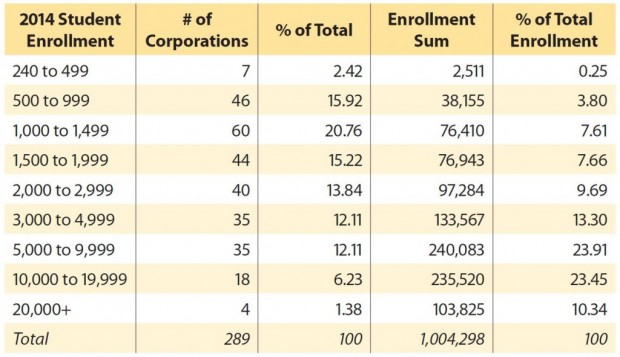Report: Academics Lag At Small Indiana School Districts

Enrollment level of Indiana school corporations based on Indiana Department of Education data. (Indiana Chamber)
Indiana school districts with 2,000 or fewer students lag behind academically as compared to larger corporations, according to a study commissioned by the Indiana Chamber and released Tuesday.
The report, conducted by researchers at Ball State University, found that the enrollment size of a school corporation correlates with student test scores and access to college prep courses.
As a result, students could struggle to get into their college program of choice or be prepared for a job, according to the report authors.
Indiana Chamber President and CEO Kevin Brinegar says the report further backs the Chamber’s position that smaller districts should consider consolidating with a nearby corporation to maximize limited state funding and offer students more academic options.
“We believe state and local action is needed to change this reality going forward,” he says. “This is simply not fair to these students who happen to live in small school districts.”
Nearly 40 percent of the state’s 289 school corporations have less than 2,000 students, according to 2014 data. Of those, 53 corporations have less than 1,000 students. Out of Indiana’s 91 counties, only 21 have a single school corporation.
The counties with the most are Lake, with 16 districts, and Marion County with 11 districts.
Michael Hicks, report co-author and researcher with Ball State’s Center for Business and Economic Research, says data shows students enrolled in a district with more than 2,000 students performed better on various tests.
Those students scored about 20 points more on the SAT than students at smaller districts.
“That is statistically significant and policy significant variable because that affects college entrance,” Hicks says.
The higher academic performance was found in other areas at larger districts: AP students pass exams at a higher rate, 15 percentage points, and the pass rate for the ISTEP is 5 percentage point more for eighth grade students.
But that’s not the case for all small districts.
The Southwestern Consolidated School District in Shelbyville is currently rated an A on the state’s A-F accountability scale. The school has been rated an A or B since 2011.
Recently passed legislation, supported by the Chamber, aimed to incentivize small
school districts to consolidate administrative functions by offering additional funding.
Brinegar says the additional legislation could be proposed for the 2018 legislative session to offer more reasons to consolidate.
The new study, School Corporation Size & Student Performance, measured college prep tests, AP exam pass rates, end of course evaluations for Algebra I and other subjects, and ISTEP scores between 2011 and 2014. Graduation rates and diploma types were not used in the study.
Test scores were adjusted for the socioeconomic differences in the school districts.
Size didn’t matter in pass rates of fourth-grade ISTEP or 10th grade end-of-course English exams.
Hicks reported that those subject areas are “low cost,” meaning districts are not struggling to afford English teachers or classroom resources.
The study did not look at individual schools.